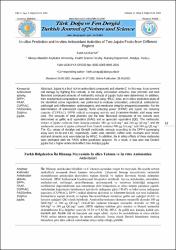| dc.description.abstract | Jujube is a fruit rich in antioxidant compounds and vitamin C. In this way, it can prevent cell damage by fighting free radicals. In the study, antioxidant activities, total phenolic and total flavonoid compound amounts of methanolic extracts of jujube fruits were determined. In addition, their biochemical compositions were determined using HPLC. Also, an in silico prediction study of the identified active ingredients was performed to evaluate antioxidant, antiradical, antibacterial, antifungal, anti-inflammatory, antimutagenic, and membrane integrity antagonist properties. For the determination of antioxidant capacity, ferric reducing power (FRAP) and cupric ion reducing capacity (CUPRAC), DPPH radical scavenging activity and β-carotene-linoleic acid assay were used. The amounts of total phenolic and the total flavonoid compounds of the extracts were determined as gallic acid equivalent (GAE) and as quercetin equivalent (QE). The methanolic extract of jujube collected from Antalya contains 580 μg GAE.mg-1 and 240 μg QE.mg-1, and the methanolic extract of jujube collected from Denizli contains 900 μg GA.mg-1 and 380 μg QE.mg-1. The IC50 values of Antalya and Denizli methanolic extracts according to the DPPH scavenging assay were 10.34 and 9.82, respectively. Gallic acid, catechin, caffeic acid, coumaric acid, ferulic acid and cinnamic acid were detected by HPLC. In addition, the in silico effects of these molecules were estimated with the PASS online prediction program. As a result, it was seen that Denizli jujube had a higher antioxidant effect than Antalya jujube. | en_US |


















